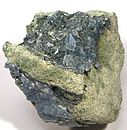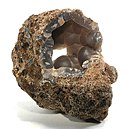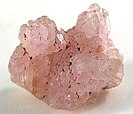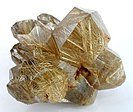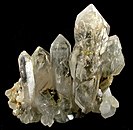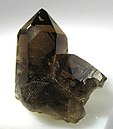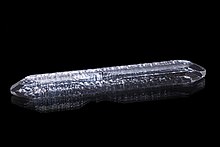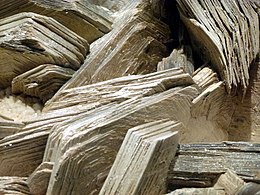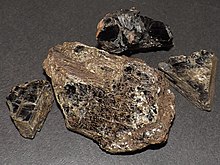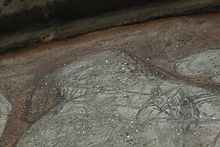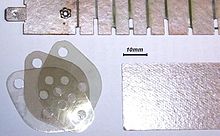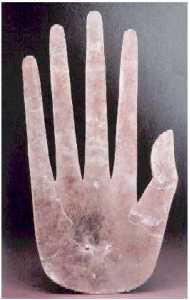| Quartz | |
|---|---|
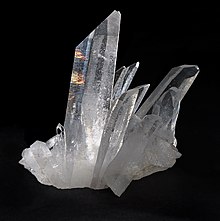
Quartz crystal cluster from Tibet
| |
| General | |
| Category | oxide mineral |
| Formula (repeating unit) | SiO2 |
| Strunz classification | 4.DA.05 (Oxides) |
| Dana classification | 75.01.03.01 (tectosilicates) |
| Crystal system | α-quartz: trigonal β-quartz: hexagonal |
| Crystal class | α-quartz: trapezohedral (class 3 2); β-quartz: trapezohedral (class 6 2 2) |
| Unit cell | a = 4.9133 Å, c = 5.4053 Å; Z=3 |
| Identification | |
| Formula mass | 60.083 g·mol−1 |
| Color | Colorless through various colors to black |
| Crystal habit | 6-sided prism ending in 6-sided pyramid (typical), drusy, fine-grained to microcrystalline, massive |
| Twinning | Common Dauphine law, Brazil law and Japan law |
| Cleavage | {0110} Indistinct |
| Fracture | Conchoidal |
| Tenacity | Brittle |
| Mohs scale hardness | 7 – lower in impure varieties (defining mineral) |
| Luster | Vitreous – waxy to dull when massive |
| Streak | White |
| Diaphaneity | Transparent to nearly opaque |
| Specific gravity | 2.65; variable 2.59–2.63 in impure varieties |
| Optical properties | Uniaxial (+) |
| Refractive index | nω = 1.543–1.545 nε = 1.552–1.554 |
| Birefringence | +0.009 (B-G interval) |
| Pleochroism | None |
| Melting point | 1670 °C (β tridymite) 1713 °C (β cristobalite) |
| Solubility | Insoluble at STP; 1 ppmmass at 400 °C and 500 lb/in2 to 2600 ppmmass at 500 °C and 1500 lb/in2 |
| Other characteristics | lattice: hexagonal, Piezoelectric, may be triboluminescent, chiral (hence optically active if not racemic) |
Quartz is a hard, crystalline mineral composed of silicon and oxygen atoms. The atoms are linked in a continuous framework of SiO4 silicon–oxygen tetrahedra, with each oxygen being shared between two tetrahedra, giving an overall chemical formula of SiO2. Quartz is the second most abundant mineral in Earth's continental crust, behind feldspar.
Quartz exists in two forms, the normal α-quartz and the high-temperature β-quartz, both of which are chiral. The transformation from α-quartz to β-quartz takes place abruptly at 573 °C (846 K). Since the transformation is accompanied by a significant change in volume, it can easily induce fracturing of ceramics or rocks passing through this temperature threshold.
There are many different varieties of quartz, several of which are semi-precious gemstones. Since antiquity, varieties of quartz have been the most commonly used minerals in the making of jewelry and hardstone carvings, especially in Eurasia.
Etymology
The word "quartz" is derived from the German word "Quarz", which had the same form in the first half of the 14th century in Middle High German in East Central German and which came from the Polish dialect term kwardy, which corresponds to the Czech term tvrdý ("hard").
The Ancient Greeks referred to quartz as κρύσταλλος (krustallos) derived from the Ancient Greek κρύος (kruos) meaning "icy cold", because some philosophers (including Theophrastus) apparently believed the mineral to be a form of supercooled ice. Today, the term rock crystal is sometimes used as an alternative name for the purest form of quartz.
Crystal habit and structure
Quartz mineral embedded in limestone (top right of the sample), easily identifiable by its hexagonal form. It cannot be scratched by steel (see Mohs scale).
Quartz belongs to the trigonal crystal system. The ideal crystal shape is a six-sided prism terminating with six-sided pyramids at each end. In nature quartz crystals are often twinned
(with twin right-handed and left-handed quartz crystals), distorted, or
so intergrown with adjacent crystals of quartz or other minerals as to
only show part of this shape, or to lack obvious crystal faces
altogether and appear massive. Well-formed crystals typically form in a
'bed' that has unconstrained growth into a void; usually the crystals
are attached at the other end to a matrix and only one termination
pyramid is present. However, doubly terminated crystals do occur where
they develop freely without attachment, for instance within gypsum. A quartz geode is such a situation where the void is approximately spherical in shape, lined with a bed of crystals pointing inward.
α-quartz crystallizes in the trigonal crystal system, space group P3121 or P3221 depending on the chirality. β-quartz belongs to the hexagonal system, space group P6222 and P6422, respectively.
These space groups are truly chiral (they each belong to the 11
enantiomorphous pairs). Both α-quartz and β-quartz are examples of
chiral crystal structures composed of achiral building blocks (SiO4
tetrahedra in the present case). The transformation between α- and
β-quartz only involves a comparatively minor rotation of the tetrahedra
with respect to one another, without change in the way they are linked.
Varieties (according to microstructure)
Although
many of the varietal names historically arose from the color of the
mineral, current scientific naming schemes refer primarily to the
microstructure of the mineral. Color is a secondary identifier for the
cryptocrystalline minerals, although it is a primary identifier for the
macrocrystalline varieties.
| ||||||||||||||||||||||||||||||||||||||||||||||||||||||||||||
Varieties (according to color)
Quartz crystal demonstrating transparency
Pure quartz, traditionally called rock crystal or clear quartz, is colorless and transparent or translucent, and has often been used for hardstone carvings, such as the Lothair Crystal. Common colored varieties include citrine, rose quartz, amethyst, smoky quartz, milky quartz, and others. These color differentiations arise from chromophores which have been incorporated into the crystal structure of the mineral. Polymorphs of quartz include: α-quartz (low), β-quartz, tridymite, moganite, cristobalite, coesite, and stishovite.
The most important distinction between types of quartz is that of macrocrystalline (individual crystals visible to the unaided eye) and the microcrystalline or cryptocrystalline varieties (aggregates
of crystals visible only under high magnification). The
cryptocrystalline varieties are either translucent or mostly opaque,
while the transparent varieties tend to be macrocrystalline. Chalcedony is a cryptocrystalline form of silica consisting of fine intergrowths of both quartz, and its monoclinic polymorph moganite.
Other opaque gemstone varieties of quartz, or mixed rocks including
quartz, often including contrasting bands or patterns of color, are agate, carnelian or sard, onyx, heliotrope, and jasper.
Amethyst
Amethyst
is a form of quartz that ranges from a bright vivid violet to dark or
dull lavender shade. The world's largest deposits of amethysts can be
found in Brazil, Mexico, Uruguay, Russia, France, Namibia and Morocco.
Sometimes amethyst and citrine are found growing in the same crystal. It
is then referred to as ametrine. An amethyst is formed when there is iron in the area where it was formed.
Blue quartz
Blue quartz contains inclusions of fibrous magnesio-riebeckite or crocidolite.
Dumortierite quartz
Inclusions of the mineral dumortierite within quartz pieces often result in silky-appearing splotches with a blue hue, shades giving off purple and/or grey
colors additionally being found. "Dumortierite quartz" (sometimes
called "blue quartz") will sometimes feature contrasting light and dark
color zones across the material.
Interest in the certain quality forms of blue quartz as a collectible
gemstone particularly arises in India and in the United States.
Citrine
Citrine is a variety of quartz whose color ranges from a pale yellow to brown due to ferric impurities. Natural citrines are rare; most commercial citrines are heat-treated amethysts or smoky quartzes.
However, a heat-treated amethyst will have small lines in the crystal,
as opposed to a natural citrine's cloudy or smokey appearance. It is
nearly impossible to differentiate between cut citrine and yellow topaz visually, but they differ in hardness. Brazil is the leading producer of citrine, with much of its production coming from the state of Rio Grande do Sul. The name is derived from the Latin word citrina which means "yellow" and is also the origin of the word "citron". Sometimes citrine and amethyst can be found together in the same crystal, which is then referred to as ametrine. Citrine has been referred to as the "merchant's stone" or "money stone", due to a superstition that it would bring prosperity.
Citrine was first appreciated as a golden-yellow gemstone in
Greece between 300 and 150 BC, during the Hellenistic Age. The yellow
quartz was used prior to that to decorate jewelry and tools but it was
not highly sought after.
Milky quartz
Milk quartz or milky quartz is the most common variety of crystalline quartz. The white color is caused by minute fluid inclusions of gas, liquid, or both, trapped during crystal formation, making it of little value for optical and quality gemstone applications.
Rose quartz
Rose
quartz is a type of quartz which exhibits a pale pink to rose red hue.
The color is usually considered as due to trace amounts of titanium, iron, or manganese, in the material. Some rose quartz contains microscopic rutile needles which produces an asterism in transmitted light. Recent X-ray diffraction studies suggest that the color is due to thin microscopic fibers of possibly dumortierite within the quartz.
Additionally, there is a rare type of pink quartz (also
frequently called crystalline rose quartz) with color that is thought to
be caused by trace amounts of phosphate or aluminium. The color in crystals is apparently photosensitive and subject to fading. The first crystals were found in a pegmatite found near Rumford, Maine, USA and in Minas Gerais, Brazil.
Smoky quartz
Smoky quartz
is a gray, translucent version of quartz. It ranges in clarity from
almost complete transparency to a brownish-gray crystal that is almost
opaque. Some can also be black. The translucency results from natural
irradiation creating free silicon within the crystal.
Prasiolite
Prasiolite, also known as vermarine, is a variety of quartz that is green in color. Since 1950, almost all natural prasiolite has come from a small Brazilian mine, but it is also seen in Lower Silesia in Poland. Naturally occurring prasiolite is also found in the Thunder Bay area of Canada. It is a rare mineral in nature; most green quartz is heat-treated amethyst.
Synthetic and artificial treatments
A synthetic quartz crystal grown by the hydrothermal method, about 19 cm long and weighing about 127 grams
Not all varieties of quartz are naturally occurring. Some clear quartz crystals can be treated using heat or gamma-irradiation
to induce color where it would not otherwise have occurred naturally.
Susceptibility to such treatments depends on the location from which the
quartz was mined.
Prasiolite,
an olive colored material, is produced by heat treatment; natural
prasiolite has also been observed in Lower Silesia in Poland. Although
citrine occurs naturally, the majority is the result of heat-treating
amethyst or smoky quartz. Carnelian is widely heat-treated to deepen its color.
Because natural quartz is often twinned, synthetic quartz is produced for use in industry. Large, flawless, single crystals are synthesized in an autoclave via the hydrothermal process; emeralds are also synthesized in this fashion.
Like other crystals, quartz may be coated with metal vapors to give it an attractive sheen.
Occurrence
Granite rock in the cliff of Gros la Tête on Aride Island, Seychelles.
The thin (1–3 cm wide) brighter layers are quartz veins, formed during
the late stages of crystallization of granitic magmas. They are
sometimes called "hydrothermal veins".
Quartz is a defining constituent of granite and other felsic igneous rocks. It is very common in sedimentary rocks such as sandstone and shale. It is a common constituent of schist, gneiss, quartzite and other metamorphic rocks. Quartz has the lowest potential for weathering in the Goldich dissolution series and consequently it is very common as a residual mineral in stream sediments and residual soils.
While the majority of quartz crystallizes from molten magma, much quartz also chemically precipitates from hot hydrothermal veins as gangue, sometimes with ore minerals like gold, silver and copper. Large crystals of quartz are found in magmatic pegmatites. Well-formed crystals may reach several meters in length and weigh hundreds of kilograms.
Naturally occurring quartz crystals of extremely high purity, necessary for the crucibles and other equipment used for growing silicon wafers in the semiconductor industry, are expensive and rare. A major mining location for high purity quartz is the Spruce Pine Gem Mine in Spruce Pine, North Carolina, United States. Quartz may also be found in Caldoveiro Peak, in Asturias, Spain.
The largest documented single crystal of quartz was found near Itapore, Goiaz, Brazil; it measured approximately 6.1×1.5×1.5 m and weighed 39,916 kilograms.
Related silica minerals
Tridymite and cristobalite are high-temperature polymorphs of SiO2 that occur in high-silica volcanic rocks. Coesite is a denser polymorph of SiO2
found in some meteorite impact sites and in metamorphic rocks formed at
pressures greater than those typical of the Earth's crust. Stishovite is a yet denser and higher-pressure polymorph of SiO2 found in some meteorite impact sites. Lechatelierite is an amorphous silica glass SiO2 which is formed by lightning strikes in quartz sand.
History
The word "quartz" comes from the German  Quarz, which is of Slavic origin (Czech miners called it křemen). Other sources attribute the word's origin to the Saxon word Querkluftertz, meaning cross-vein ore.
Quarz, which is of Slavic origin (Czech miners called it křemen). Other sources attribute the word's origin to the Saxon word Querkluftertz, meaning cross-vein ore.
Quartz is the most common material identified as the mystical substance maban in Australian Aboriginal mythology. It is found regularly in passage tomb cemeteries in Europe in a burial context, such as Newgrange or Carrowmore in Ireland. The Irish word for quartz is grianchloch, which means 'sunstone'. Quartz was also used in Prehistoric Ireland, as well as many other countries, for stone tools; both vein quartz and rock crystal were knapped as part of the lithic technology of the prehistoric peoples.
While jade has been since earliest times the most prized semi-precious stone for carving in East Asia and Pre-Columbian America, in Europe and the Middle East the different varieties of quartz were the most commonly used for the various types of jewelry and hardstone carving, including engraved gems and cameo gems, rock crystal vases,
and extravagant vessels. The tradition continued to produce objects
that were very highly valued until the mid-19th century, when it largely
fell from fashion except in jewelry. Cameo technique exploits the bands
of color in onyx and other varieties.
Roman naturalist Pliny the Elder believed quartz to be water ice, permanently frozen after great lengths of time. (The word "crystal" comes from the Greek word κρύσταλλος,
"ice".) He supported this idea by saying that quartz is found near
glaciers in the Alps, but not on volcanic mountains, and that large
quartz crystals were fashioned into spheres to cool the hands. This idea
persisted until at least the 17th century. He also knew of the ability
of quartz to split light into a spectrum.
In the 17th century, Nicolas Steno's study of quartz paved the way for modern crystallography. He discovered that regardless of a quartz crystal's size or shape, its long prism faces always joined at a perfect 60° angle.
Quartz's piezoelectric properties were discovered by Jacques and Pierre Curie in 1880. The quartz oscillator or resonator was first developed by Walter Guyton Cady in 1921. George Washington Pierce designed and patented quartz crystal oscillators in 1923. Warren Marrison created the first quartz oscillator clock based on the work of Cady and Pierce in 1927.
Efforts to synthesize quartz began in the mid nineteenth century
as scientists attempted to create minerals under laboratory conditions
that mimicked the conditions in which the minerals formed in nature:
German geologist Karl Emil von Schafhäutl (1803–1890) was the first person to synthesize quartz when in 1845 he created microscopic quartz crystals in a pressure cooker. However, the quality and size of the crystals that were produced by these early efforts were poor.
By the 1930s, the electronics industry had become dependent on
quartz crystals. The only source of suitable crystals was Brazil;
however, World War II disrupted the supplies from Brazil, so nations
attempted to synthesize quartz on a commercial scale. German
mineralogist Richard Nacken (1884–1971) achieved some success during the
1930s and 1940s.
After the war, many laboratories attempted to grow large quartz
crystals. In the United States, the U.S. Army Signal Corps contracted
with Bell Laboratories and with the Brush Development Company of Cleveland, Ohio to synthesize crystals following Nacken's lead.
(Prior to World War II, Brush Development produced piezoelectric
crystals for record players.) By 1948, Brush Development had grown
crystals that were 1.5 inches (3.8 cm) in diameter, the largest to date. By the 1950s, hydrothermal synthesis
techniques were producing synthetic quartz crystals on an industrial
scale, and today virtually all the quartz crystal used in the modern
electronics industry is synthetic.
- Rock crystal jug with cut festoon decoration by Milan workshop from the second half of the 16th century, National Museum in Warsaw. The city of Milan, apart from Prague and Florence, was the main Renaissance centre for crystal cutting.
- Synthetic quartz crystals produced in the autoclave shown in Western Electric's pilot hydrothermal quartz plant in 1959
- Fatimid ewer in carved rock crystal (clear quartz) with gold lid, c. 1000.
Piezoelectricity
Some types of quartz crystals have piezoelectric properties; they develop an electric potential upon the application of mechanical stress. An early use of this property of quartz crystals was in phonograph pickups. One of the most common piezoelectric uses of quartz today is as a crystal oscillator. The quartz clock
is a familiar device using the mineral. The resonant frequency of a
quartz crystal oscillator is changed by mechanically loading it, and
this principle is used for very accurate measurements of very small mass
changes in the quartz crystal microbalance and in thin-film thickness monitors.








